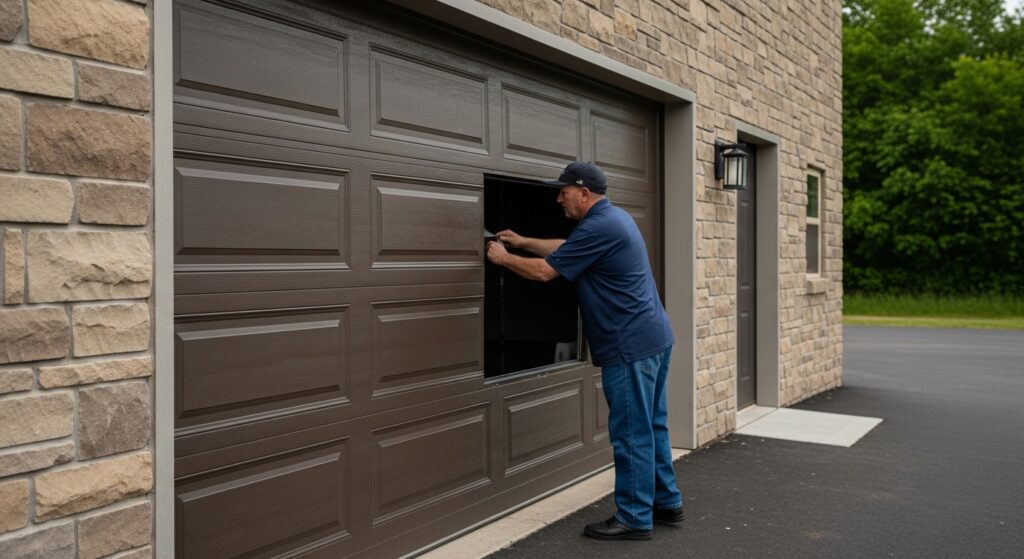Garage door springs are among the most important components in your entire garage door system. They do the heavy lifting—literally. Every time you open or close your garage door, the springs counterbalance its weight, making it feel light enough for the opener or even a person to lift with ease. When garage door springs begin to wear out, become unbalanced, or break entirely, the entire system becomes unsafe and potentially unusable.
This guide will help homeowners understand how garage door springs work, why they fail, what warning signs to watch for, and what to do when a problem arises. Because springs hold large amounts of tension, understanding them is crucial for anyone looking to keep their garage door system safe, functional, and long-lasting.
Understanding the Role of Garage Door Springs
Most homeowners are surprised to learn that the garage door opener does not lift the door by itself. Instead, the springs carry the weight, and the opener simply guides the door’s movement.
A typical garage door weighs between 120 and 300 pounds, yet a properly functioning spring system makes it feel nearly weightless. Without the springs, the opener would burn out immediately, and the door would be impossible to lift safely.
There are two main types of garage door springs:
1. Torsion Springs
Torsion springs are the most common modern system. They sit horizontally above the garage door and twist tightly when the door closes. This twisting action stores tension, and when the door opens, the stored energy is released to lift it.
Advantages of torsion springs
- More durable than extension springs
- Provide smoother, more controlled motion
- Better balance for heavier doors
- Safer design overall
Most newer homes feature torsion spring systems because of their efficient operation and long lifespan.
2. Extension Springs
Extension springs run vertically on either side of the garage door tracks. They expand and contract as the door closes and opens.
Advantages of extension springs
- Lower initial cost
- Common in older garage door installations
While still used today, extension springs require more safety precautions. They move more dramatically, stretch under tension, and can cause greater damage if they fail.
Why Garage Door Springs Fail
Springs do not last forever. Their lifespan depends largely on cycles—one cycle equals one open and one close of the door.
Most standard garage door springs last between 10,000 and 15,000 cycles. If a household uses the door several times per day, the springs may only last 5–10 years.
The most common causes of spring failure include:
1. Natural Wear and Tear
Every cycle puts tension on the springs. Over time, metal fatigue sets in. The coils weaken and eventually break. This is the most common cause of spring failure and the easiest to predict.
2. Rust and Corrosion
Moisture in the air can cause springs to rust. As rust builds on the coils, tension weakens, friction increases, and the metal deteriorates. Regular lubrication helps prevent this.
3. Imbalanced or Unmaintained Door
When a garage door becomes unbalanced, the springs strain unevenly. This accelerates wear, especially on one side of the system.
4. Extreme Temperature Changes
Cold weather can make metal more brittle, while heat can cause expansion. Both conditions put added stress on springs and shorten their lifespan.
5. Incorrect Spring Type or Size
If the springs installed on a garage door are the wrong size or strength for its weight, they will fail prematurely. This is why proper professional installation is so important.
Warning Signs Your Garage Door Springs Need Repair
A garage door spring rarely fails without warning. Homeowners who know what to look for can prevent dangerous breakdowns.
1. Loud Bang from the Garage
One of the most obvious signs of a broken torsion spring is a sudden loud bang, similar to a firecracker or gunshot. This happens when the spring snaps under tension.
2. Door Feels Extremely Heavy
If a spring is broken, the door immediately becomes far heavier than normal. Trying to lift the door manually may feel nearly impossible.
3. Door Won’t Open or Only Opens a Few Inches
Garage door openers are built with safety mechanisms. When a spring breaks, the opener senses the imbalance and stops lifting to prevent burning out the motor. As a result, the door may:
- Not open at all
- Open halfway and stop
- Reverse automatically
4. Visible Gaps in the Spring
On torsion springs, a break leaves a noticeable gap between the coils. On extension springs, the break may cause the spring to stretch out or hang loosely.
5. Crooked or Uneven Door Movement
If one spring breaks, the door may tilt, jerk, or appear uneven during operation. This is especially common with extension springs.
6. Excessive Noise During Operation
While garage doors naturally produce some noise, loud squeaking, scraping, or grinding sounds may indicate worn springs or springs rubbing incorrectly against hardware.
7. Cables Look Loose or Unraveled
Damaged springs sometimes cause lifting cables to loosen, unwind, or hang out of place. This is a clear sign that the door’s counterbalance system is compromised.
Why Broken Garage Door Springs Are Dangerous
A broken spring is one of the most serious garage door issues. Garage doors are heavy, and springs hold immense tension. When they fail:
- The door can fall suddenly and without warning
- The opener can burn out attempting to lift the full weight
- Metal can snap back or fly into nearby walls
- Components can loosen or detach unexpectedly
Attempting to repair or replace springs without proper tools and experience is extremely dangerous. Even highly skilled DIY homeowners risk serious injury. Spring repair is one of the most crucial tasks best left to trained professionals.
What to Do if a Spring Breaks
If you suspect a garage door spring has broken, take the following steps:
1. Stop Using the Door Immediately
Avoid operating the opener and do not attempt to lift the door manually. Using the door can cause additional damage and create hazardous conditions.
2. Disconnect the Opener
Most openers have a manual release cord. Pulling it disengages the motor. This prevents someone from accidentally trying to use the door.
3. Keep Clear of the Door
A broken spring can make the door unstable. Avoid walking under the door or standing close to it.
4. Avoid DIY Spring Repair
Garage door springs require:
- Proper tension calibration
- Correct tools
- Safety protocols
- Technical expertise
Attempting DIY spring repair can result in property damage or injury.
How Springs Are Professionally Repaired
Professional spring repair involves several steps to ensure safety and proper functionality.
1. Inspection and Diagnosis
A technician examines:
- The type of springs
- The condition of both springs (they typically wear evenly)
- The cables, bearings, drums, and other components
- The balance of the door
This ensures the entire system is evaluated—not just the broken part.
2. Removing the Broken Springs
Professionals use specialized winding bars, locking pliers, and safety tools to carefully remove springs under tension.
3. Installing the Correct Replacement Springs
The right springs must match:
- Door weight
- Height
- Track system
- Opener type
- Lift type (standard, high-lift, or vertical lift)
Using incorrect springs can damage the entire system, so proper sizing is crucial.
4. Balancing and Tensioning the System
Once springs are installed, technicians wind them to the proper tension. The door is then tested manually to ensure:
- Smooth movement
- Balanced weight
- Controlled operation
A correctly balanced door should be easy to lift and should stay in place when moved halfway up.
5. System Lubrication and Safety Testing
A complete repair includes:
- Lubricating springs and moving parts
- Tightening bolts and track hardware
- Testing safety sensors
- Ensuring smooth operation
This final step ensures the door is safe and fully functional.
How to Extend the Lifespan of Garage Door Springs
While all springs eventually wear out, homeowners can extend their lifespan with proper care.
1. Lubricate the Springs Regularly
High-quality lubricant helps prevent rust and reduces friction. Applying lubricant every few months keeps coils moving smoothly.
2. Keep the Door Balanced
If you ever notice uneven movement or sagging, a technician should inspect and balance the door. This prevents premature spring wear.
3. Avoid Overusing the Door
Treating the garage door like a main entrance increases cycle count. Whenever possible, reduce unnecessary use to protect the springs.
4. Maintain Other Components
Rollers, tracks, and hinges all affect how smoothly the door moves. When these parts wear out, they put more strain on the springs.
5. Schedule Routine Inspections
Annual inspections help catch issues early, including fraying cables, weakening hardware, or rusting springs.
Final Thoughts
Garage door springs are essential to the safety and functionality of your garage door. They handle the weight, absorb the tension, and ensure smooth operation every time you open or close your door. When they fail, the door becomes unsafe and potentially unusable.
By understanding how springs work, recognizing warning signs, and taking the right steps when a problem occurs, homeowners can protect their property and prevent serious accidents. While it may be tempting to attempt DIY repairs, spring systems are under high tension and require expert handling. Proper repair and maintenance keep your garage door operating safely and reliably for years.

